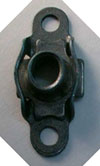Methods of Pre-loading
 After having calculated bolt stiffness, or measured the load-deflection curve directly, the best way to calculate pre-load is to measure the extension of the bolt directly. This method is preferred for con rod bolts and all con rod and bolt suppliers generally recommend this method. The fasteners require design features to allow measurement with a special micrometer. This method is impossible for fasteners in blind holes. For large fasteners in blind holes the extension can be measured directly if there is sufficient access for other measuring equipment.
After having calculated bolt stiffness, or measured the load-deflection curve directly, the best way to calculate pre-load is to measure the extension of the bolt directly. This method is preferred for con rod bolts and all con rod and bolt suppliers generally recommend this method. The fasteners require design features to allow measurement with a special micrometer. This method is impossible for fasteners in blind holes. For large fasteners in blind holes the extension can be measured directly if there is sufficient access for other measuring equipment.
Ultrasonic methods are very accurate but don't seem to be in widespread use in motor sport. There are three other methods which seem common; tightening to yield using operator feel, measuring torque and calculating the tension from a mathematical relationship, and 'torque plus angle' where the bolt is tightened to a certain torque, then tightened by an additional angle.
When we tighten a bolt or nut, there is a shear stress due to torsion in the bolt; this is known to relax to a large extent once the applied torque is removed. So, if we tighten to yield, the torsional stresses will relax, allowing the material to go back below yield (ref 1), having already work-hardened the material slightly (be careful that what you feel is NOT the threads being pulled out of the casting!). If the service loads are low, we can be sure that the bolt will not surpass yield in service.
There are two main methods of calculating the relationship between torque and tension. One is to calculate this from first principles using assumed or measured values of friction for the nut face (or bolt face) contacts and the thread contact areas, the thread pitch and other dimensional details. The method is felt to have an accuracy of ±15 - ±30%, with the lower figure being based on close dimensional control of all parts involved and accurate data on friction. Friction data can come from published sources, or from your own tests.
The second method is called the nut factor method. Use this method cautiously, unless you make measurements to calculate the nut factor for each joint. It is folly to accept a given nut factor value for 1/2" bolts in steel as an example, and expect it to give good results if the fasteners and lubricants used are not the same as used to generate the nut factor value. Changes in thread pitch and friction have an effect on the torque-tension relationship; be sure that you understand the limitations of the nut-factor method before using it.
Torque-plus-angle is a method where a 'snugging' torque is applied to take the joint beyond the initial non-linear portion of the torque-tension curve. Application of the tightening angle in stages also removes much of the incertitude due to relaxation. For example, 300 degrees of angle might be applied as 3 x 100 degrees.
We can mitigate the variation in pre-load by conditioning the joint before final tightening, especially when using new parts. Tightening the joint, and then releasing the load completely allows the parts to 'bed-in' before proceeding with the final tightening. Some fastener suppliers recommend this procedure and some engine builders do this on critical applications. Pre-load relaxation is a fact of life, even where best practice is followed. Published data (ref 2) considers that 5% loss of pre-load is an acceptable allowance, but 10% relaxation is possible.
References:
John H. Bickford, An Introduction to the Design and Behavior of Bolted Joints, Marcel-Dekker, 1981, ISBN 0-8247-1508-X
Space Shuttle - Criteria for Preloaded Bolts, NASA NSTS 08307, 1998
Written by Wayne Ward.